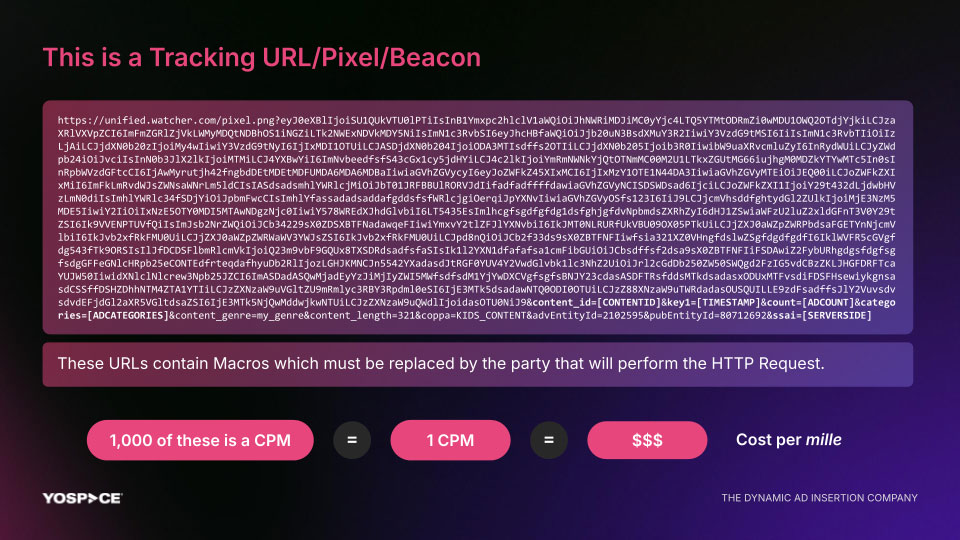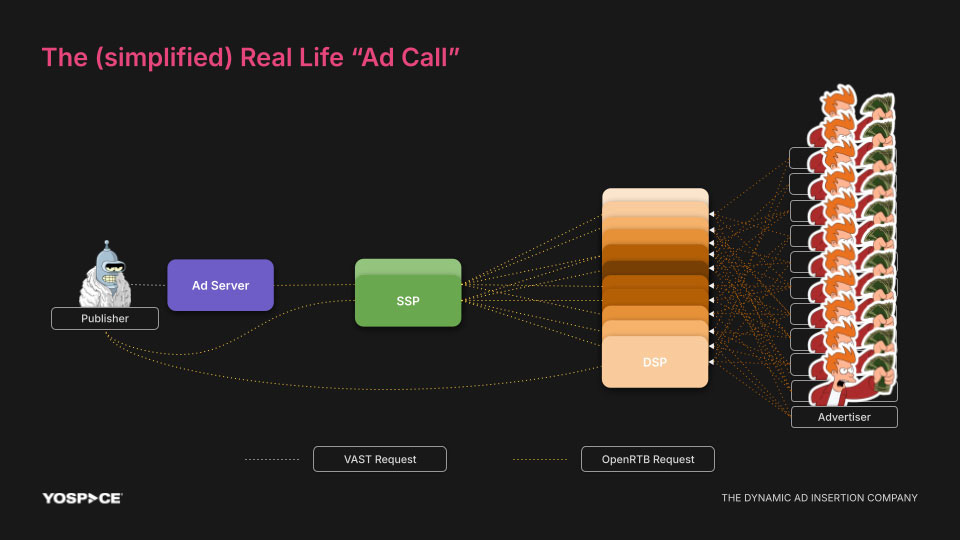Olivier Cortambert
Head of Solution Architecture, Yospace
When people think about monetising video, they often focus only on ad insertion: getting the mid-rolls, pre-rolls, and post-rolls just right. But the reality is this: ad insertion on its own doesn’t pay, ad insertion and measurement does.
If you want to build sustainable and scalable revenue in streaming, you have to prove value. That proof comes from data. Not just whether an ad was delivered, but whether it was seen, heard, completed, and engaged with. Through the IAB's standardisation work, the industry has established a consistent means of achieving this. That is what ad measurement is all about.
In this article, I’ll explain why ad measurement (not just ad insertion) is what drives real value. I’ll explore how tracking works today and how emerging standards are changing how we think about ad delivery across devices, formats, and viewing environments.

At its core, ad measurement starts with something deceptively simple: a tracking URL, often known as a tracking pixel or beacon. You can see an example of this in the picture above.
The name ‘pixel’ comes from the very beginning of web display advertising, where the tracker would be a 1x1 pixel GIF image loaded by the browser (therefore, in video advertising, which covers a multitude of devices, not just web browsers), it is perhaps more appropriate to use the term ‘beacons’ or ‘trackers’. When the URL is called, the server on the receiving end will log that transaction.
Each time a viewer is shown an ad, a specific tracking URL is called. For example, when playback starts, mutes or skips, or the ad completes, a tracking beacon will be called. This may be described in the ad tech world as a ‘pixel/beacon/tracker firing’. These URLs often contain dynamically replaceable strings referred to as macros or tokens. These are placeholders that must be replaced by the player or server to fill in contextual information that is only known by the client at the time of firing the beacon.
Advertisers pay based on impressions, usually calculated per thousand ad plays (CPM, cost per mille). So, every time that tracking URL is triggered 1,000 times (in other words, when the ad has been started 1,000 times), it represents one CPM unit, and ultimately, that is where the money comes in.
In other words, you don’t get paid when you insert the ad. You get paid when the tracking pixels confirm the ad was actually played.
Tracking pixels are fired at specific moments during playback. These fall into two key categories:
The first is referred to as “standard measurement”. This encompasses various types of playback measurement, which include a tracking pixel firing impressions (when an ad begins), quartiles (25%, 50% and 75% progress gates), and completions (when an ad ends). It also references user interactions with the ad, such as muting/unmuting, expanding/collapsing the window, click-throughs, or ad skips.
The second is referred to as “enhanced measurement”. As the name suggests, this provides a bit more context, specifically on ad viewability. This can include volume level, the amount of screen space the ad occupies, or whether the ad is displayed at all.
Some ad servers may include ‘bookend’ beacons at the start and end of the break, primarily to support ancillary functions such as forecasting and operational reporting, not “standard measurement”.
Each of these tracking events provide crucial context to advertisers. To assess the impact on metrics like website traffic, sales, and overall campaign effectiveness, advertisers need to know whether it was viewed, played in a sound-on environment, and played for a meaningful duration.
To broadcasters or publishers, measurement is not only a means of being paid, it can be an invaluable tool allowing them to forecast their inventory and thus sales strategy, and to help their partners in the programmatic ecosystem pace third-party demand.
Behind every ad impression is a complex ecosystem. At the top of the chain is the broadcaster or publisher, who owns the content and the ad inventory.
The ad server manages campaigns and decides which ads to play and when. The supply-side platform (SSP) groups publishers together and offers available ad slots to buyers. The demand-side platform (DSP) represents advertisers who are looking to purchase those slots.

When an ad slot becomes available, many real-time bidding requests are made. SSPs reach out to multiple DSPs, which then bid to fill that slot.
Each player in this chain, the publisher, the SSP, and the DSP, needs confirmation that their part of the deal has occurred. A single ad impression can therefore trigger multiple tracking URLs, one for each stakeholder. Bidders for placement may use the ratio of winning bids to ad impressions to set the bid responses and pacing.
This makes ad measurement both technically intricate and data-heavy. But without it, nobody gets paid, and advertisers will lose trust in the system.
In today’s streaming world, Server-Side Ad Insertion (SSAI), Server-Guided Ad Insertion (SGAI), and Client-Side Ad Insertion (CSAI) are the backbone of dynamic ad delivery.
With CSAI, the player manages the entire interaction with the ad system and fires the tracking URLs directly. But in SSAI and SGAI, the player doesn’t manage interactions with the ad server and thus isn’t aware of what content is on the stream by default. Here, ads are stitched into the stream on the server (SSAI) or player (SGAI), and tracking must take place simultaneously with successful playback of those assets.
Check out this explainer article on the differences between CSAI, SSAI, and SGAI.
SSAI or SGAI vendors may provide measurement features that report playback data and send tracking beacons, such as SDKs or server-side tracking, or they may consider themselves as simply an “ad stitcher” and leave the job of ad measurement to the customer.
Add in the variety of devices, such as Connected TVs, mobile, web players, and set-top boxes, and you quickly see why maintaining accurate measurement at scale is so difficult. Connected TVs alone pose significant challenges, as sometimes more work is required to ensure an SDK aligns with widely varying device capabilities; Even devices from the same manufacturer can have different requirements!
Even basic functions, such as knowing the playhead position, can behave differently across formats and devices. In VOD, it’s more straightforward: playback starts at zero and progresses linearly. But in live SSAI or SGAI environments, players interpret time differently depending on streaming protocols such as HLS or MPEG-DASH.
That inconsistency affects how tracking data aligns with actual playback, creating potential gaps in reporting accuracy and ultimately in revenue recognition.
The industry is aware of these challenges, and two emerging standards aim to address them: SVTA Ad Creative Signalling and the latest iteration of CTA’s Common Media Client Data (CMCDv2) for Client-Guided Tracking.
Led by the Streaming Video Technology Alliance (SVTA), this approach defines a JSON-based standard for delivering ad metadata to the player.
In practical terms, it provides a consistent way to embed or reference tracking data, either in-band (within the manifest) or out-of-band, so that players can interpret it without needing custom SDKs.
Version 2 of the standard defines key tracking events, such as start, quartiles, and completion, while version 3 will expand support for nonlinear and companion ads, such as L-banner or side-by-side ads.


The advantage of this model is its simplicity and transparency. Everything the player needs is described in a standard, readable format. That means less custom code, easier debugging, and faster interoperability between platforms.
The other emerging model focuses on a server-side approach. Here, the concept is to leverage the features within the CMCDv2 standard, produced by the CTA wave project. Here, the player regularly reports primitive playback state information such as playhead position and user interactions, to a measurement endpoint.
That endpoint then performs the tracking on the player’s behalf, which means there are no direct pixel calls from the device and server-side resources are required to track the state of playback.
The advantages here are that ad blockers cannot interfere, since tracking happens server-side, reducing client-side overhead while helping unify reporting across devices. As beacons are not called directly from the user, it may be argued that this method may be better placed to protect user privacy, and to prevent accidental leaking of a publisher’s audience data to third parties. Finally, reducing implementation complexity in the player may make this a good choice for devices with constrained CPU and memory.
SVTA Ad Signalling and CMCDv2 serve different but complementary roles.
In practice, most ecosystems can use both. SVTA offers rich, client-aware measurement that supports detailed analytics and viewability reporting. CMCDv2 provides resilience and consistency when client support is limited, as in the case of content syndication across third-party apps.
Of all the metrics, viewability remains the closest we can get to knowing whether someone truly watched an ad.
Viewability measurement aims to answer several questions:
This is enabled by the IAB Open Measurement SDK (OMSDK), which lets players report playback events, viewport changes, and audio volume in standardised ways. The OMSDK was intended to replace vendor-specific SDKs, although some vendor-specific viewability measurement is still active.
Each implementation must be certified by the IAB for every platform, including iOS, Android, CTV, and Web. This ensures consistent and trusted reporting across devices.
Advertisers increasingly demand this kind of verified, privacy-safe measurement because it tells them what they are really paying for.
To put it simply, rich and accurate measurement leads to:
Quality ad measurement doesn’t just improve analytics, it builds advertiser confidence.
When advertisers trust the data, they invest more. They pay higher per CPM, renew campaigns, and experiment with new formats.
In other words, measurement is revenue.
Emerging standards like SVTA Ad Creative Signalling and CTA’s CMCDv2 are paving the way toward a more interoperable and transparent ad ecosystem, one where ad delivery and measurement are finally inseparable.
As with SSAI and SGAI, there will not be a single, universal solution overnight. But by adopting a mix of these standards, we can cover all use cases and make ad-supported streaming both more profitable and more accountable.
Because at the end of the day, ad insertion doesn’t pay, ad measurement does.
This blog post was written using content from a webinar Olivier presented for Qualabs. To watch the webinar, click here.